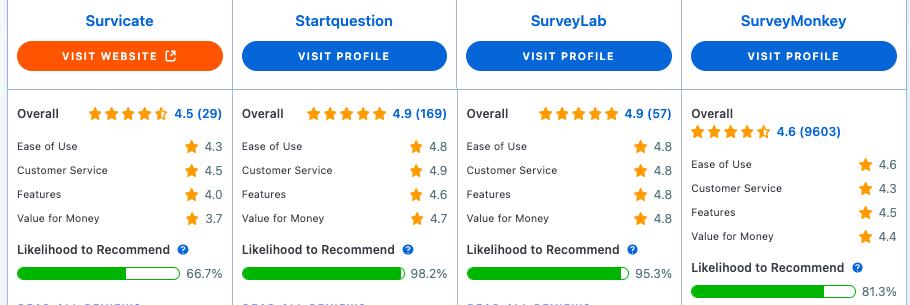In the fiercely competitive marketplace of today, businesses must grasp and manage customer expectations with precision. Customers are not just looking for products or services; they crave experiences that resonate with their needs and values. The ability to meet these expectations often spells the difference between securing loyal customers and grappling with continual dissatisfaction.
This article examines how businesses can not only meet but exceed what customers expect, forging lasting relationships and fueling growth. We delve into strategies ranging from collecting insightful feedback to anticipating future demands, providing a roadmap for success in a customer-centric world.
Satisfied Customers in Numbers
Exceeding customer expectations is crucial for businesses, directly impacting customer loyalty, retention, and profitability. Here are some up-to-date statistics that highlight the importance of meeting customer expectations:
- 81% of organizations see customer experience as a competitive advantage (ninetailed.io).
- Poor customer service leads to a $1.6 trillion annual loss in the United States due to brand-switching consumers (ninetailed.io).
- Enhancing customer experience can reduce customer churn by almost 15% and increase win rates by nearly 40% (sprinklr).
- Customers with exceptional past experiences spend 140% more than those with less favorable experiences (sprinklr).
- 48% of Gen Z, 63% of Millennials, and 53% of Gen X customers are likely to switch from a company if its communications don’t meet expectations (Smart Communications).
Healthcare Satisfaction Survey
If you run a clinic or a facility providing professional healthcare, our survey template will help you quickly gain key knowledge about patient satisfaction.
Healthcare Satisfaction Survey
If you run a clinic or a facility providing professional healthcare, our survey template will help you quickly gain key knowledge about patient satisfaction.
How Should We Define Customer Expectations?
Defining customer expectations is pivotal for delivering a positive customer experience. Let’s find out what customer expectations entail and the factors that shape them.
What Are Customer Expectations? [Definition]
Customer expectations are the beliefs or assumptions that individuals hold about a product, service, or brand. These expectations mold their perceptions and experiences, ultimately influencing their satisfaction and loyalty. Expectations can be clearly articulated by customers (explicit expectations), or unspoken yet understood through prior experiences or common knowledge (implicit expectations).
Understanding these nuances is essential for businesses aiming to meet and surpass customer expectations in a competitive market. We’ll be more than happy to show you how to do it.
Factors Influencing Customer Expectations
- Brand Perception
A well-established brand with a positive reputation sets high expectations for quality and service. The way a brand conveys its values, mission, and promises shapes customer expectations.
- Price
Customers expect the quality and benefits of a product or service to justify its price. Premium pricing often leads to higher expectations for quality and service, while budget pricing may set lower expectations.
- Product Quality
High-quality products that are durable and reliable foster positive expectations. The more features and benefits a product offers, the higher the expectations for its performance.
- Customer Service
Quick and effective responses to customer inquiries and issues set high expectations for service. Tailored interactions and solutions enhance customer expectations for a personalized experience.
- Previous Experiences
Positive past experiences with a brand elevate expectations for future interactions. Consistent quality and service reinforce positive expectations.
- Competitor Offerings
Customers compare a brand’s offerings with those of competitors, influencing their expectations. Competitors’ innovations can raise the bar for what customers expect from a brand.
- Cultural and Social Influences
Cultural trends and social norms shape what customers expect from products and services. Recommendations and reviews from friends, family, and online communities significantly influence expectations.
NPS Survey Template
The Net Promoter Score (NPS) is a world-renowned methodology and one of the best business tools for researching customer loyalty. You will draw remarkably valuable conclusions with such simple to collect and valuable feedback.
NPS Survey Template
The Net Promoter Score (NPS) is a world-renowned methodology and one of the best business tools for researching customer loyalty. You will draw remarkably valuable conclusions with such simple to collect and valuable feedback.
Why Are Customers Expectations Important to Consider?
Customer expectations directly impact satisfaction, loyalty, and business success. Meeting or exceeding these expectations fosters positive experiences and repeat business while failing to do so leads to dissatisfaction and loss of clientele. Understanding and managing customer expectations allows businesses to tailor their offerings and drive growth.
What customers expect businesses to do for them? Here’s a brief review:
Brand Loyalty and Reputation
Meeting customer needs is key to achieving higher satisfaction, which in turn fosters brand loyalty. Satisfied customers are more likely to return and recommend your brand to others, creating a ripple effect of positive word-of-mouth.
Consistently meeting expectations also builds a strong reputation, attracting new customers while retaining existing ones. This virtuous cycle of trust and loyalty not only strengthens your brand’s standing in the market but also drives sustainable growth and success.
Standing Out from the Competition
Readiness to understand customer expectations can distinguish your brand from competitors, making it the preferred choice through unique value propositions and exceptional service. Consistently delivering on promises not only builds trust but also creates a significant competitive advantage.
When customers know they can rely on your brand to meet their needs and expectations, they are more likely to choose your products or services over others, driving loyalty and market success.
Customer Retention
Ensuring customers’ needs are consistently met significantly reduces churn, as satisfied customers are less likely to switch to competitors. Retaining existing customers is not only more cost-effective than acquiring new ones but also paves the way for long-term relationships.
These enduring connections lead to repeat business and increased lifetime value, driving sustained growth and profitability for your brand. Additionally, long-term customers often become brand advocates, spreading positive word-of-mouth and attracting new clients, ultimately contributing to long-term success.
Revenue Growth
Satisfied customers are more likely to make repeat purchases and explore new products or services from your brand, driving increased sales. Additionally, happy customers often share their positive experiences with others, leading to new customer acquisition through word-of-mouth referrals.
This organic form of marketing not only expands your customer base but also enhances your brand’s reputation, creating a cycle of trust and loyalty that fuels continued growth and success.
Feedback and Improvement
Understanding what customers value most provides invaluable insights that can guide product development, service improvements, and overall business strategy. This feedback serves as a roadmap, enabling businesses to align their offerings with customer desires.
Regularly assessing and adapting to these insights ensures that companies remain relevant and continuously enhance their products and services. This proactive approach not only meets customer needs but also drives innovation and long-term success.
Customer Trust
Consistently delivering on promises builds trust, as customers are more likely to rely on a brand that proves dependable. Clear communication about what customers can expect fosters transparency, reinforcing this trust.
Transparency and reliability are crucial for establishing long-term relationships, encouraging customer loyalty and confidence in the brand. By being a trustworthy and transparent partner, businesses can nurture lasting connections that drive sustained success.
Sometimes a small gesture is enough to do something beyond the user’s expectations.
Adam Żołądź, Tech Support Specialist
Identifying Customer Expectations
Understanding what customers expect involves thorough research and asking the right questions. It’s essential to stay well-informed about your industry and its evolving trends. Such an approach requires continuous communication with your customers to ensure alignment with their needs and preferences.
Here are some key methods to determine every customer expectation:
Customer Surveys
Surveys are a direct way to gather information about customer expectations, providing valuable insights into what customers value and expect from your products or services. By asking specific questions, businesses can gain a deeper understanding of customer needs, which is crucial for enhancing customer satisfaction.
Additionally, surveys offer quantitative data that can be analyzed to identify common trends and areas for improvement. This data-driven approach ensures that businesses can make informed decisions to better meet customer demands and increase overall satisfaction.
Customer Reviews
Reviews on platforms like Google, Yelp, Booking, and social media offer valuable insights into customer experiences and dynamic performance expectations. Positive reviews highlight what your business is doing well, while negative reviews pinpoint areas needing improvement.
This insightful feedback provides real-time data, enabling you to quickly address issues and adjust your offerings to better meet customer needs. By leveraging these reviews, businesses can stay attuned to dynamic performance expectations, ensuring continuous improvement and customer satisfaction.
Social Listening
Social listening, which involves tracking mentions of your brand, products, and industry on social media platforms, is a powerful tool for understanding customer sentiment and expectations. By monitoring these conversations, you can gain valuable insights into what your customers are thinking and feeling.
Analyzing social media chatter also helps identify emerging trends and shifts, enabling your business to stay ahead of the curve and better meet customer expectations. This proactive approach ensures that you remain responsive to customer needs and maintain a competitive edge.
Customer Service Team
Your customer service team, interacting with customers daily, offers invaluable frontline insights into their expectations and common concerns. These firsthand observations are crucial for understanding what customers truly need.
By establishing a feedback loop between your customer service team and other departments, you ensure that excellent customer service standards are maintained and that customer expectations are communicated and addressed throughout the organization. This integrated approach helps align your entire business with customer needs, fostering satisfaction and loyalty.
Types of Customer Expectations
Grasping the different types of customer expectations is crucial for businesses aiming to fine-tune their strategies. By addressing explicit, implied, interpersonal, digital, performance, ethical, and emotional expectations, companies can significantly boost customer satisfaction, foster loyalty, and cultivate lasting relationships.
Precise Expectations
Specific requirements are clear and specific expectations that customers have communicated directly. For example, a customer might expect a product delivered within two days or a service available 24/7. Measurable standards are precise expectations that are often measurable, making it easier for businesses to meet or exceed them.
Implied Expectations
Unspoken assumptions are expectations that customers have without explicitly stating them. For example, customers might expect a product to be safe or a service to be reliable. These implied expectations are often based on industry norms and standards, and customers expect businesses to meet these basic requirements as a given.
Interpersonal Expectations
These expectations pertain to the quality of interactions customers have with your staff. Customers anticipate courteous, respectful, and helpful service. Customers increasingly expect personalized experiences, where businesses remember their preferences and tailor interactions accordingly.
Digital Expectations
In today’s digital era, customers expect seamless online experiences, including easy navigation, fast loading times, and mobile-friendly websites. What is more, customers anticipate timely and effective communication through digital channels, such as email, social media, and chatbots.
Ethical Expectations
Customers expect companies to act ethically and responsibly, including fair labor practices, environmental sustainability, and ethical sourcing. Transparency is also expected in business practices, including precise information about products, services, and company policies.
Customer Effort Score Survey
Satisfied customers are likelier to remain loyal and promote your brand through word-of-mouth. Many businesses turn to metrics like the Customer Effort Score (CES) to gauge customer satisfaction effectively.
Customer Effort Score Survey
Satisfied customers are likelier to remain loyal and promote your brand through word-of-mouth. Many businesses turn to metrics like the Customer Effort Score (CES) to gauge customer satisfaction effectively.
How to Exceed Customer Expectations
Whether it’s B2C or B2B customer expectations, going beyond the standard in a business relationship is always a pleasant surprise. For the customer, this type of experience can be a stepping stone to establishing a long-term, loyal relationship with the brand.
Here are some tips on how to do that.
- Getting Regular Customer Feedback
Regularly collecting feedback through surveys, reviews, and direct interactions helps you understand clients needs and expectations. Use this feedback to make continuous improvements. Show customers that their opinions matter by actively listening and implementing their suggestions.
- Apologizing For Mistakes
When mistakes happen, promptly acknowledge them and offer a sincere apology. It will show customers that you value their experience and are committed to making things right. In such a scenario, take immediate steps to rectify the issue and prevent it from happening again.
- Follow Up Your Customers
After a purchase, follow up with customers to ensure they are satisfied with their product or service. Do it through emails, calls, or surveys. It will keep your brand top-of-mind and show that you care about their ongoing experience.
- Surprise Your Customers
Delight customers with unexpected rewards such as discounts, freebies, or personalized thank-you notes. Small gestures can leave a lasting positive impression. Go beyond what you promise. For example, deliver products earlier than expected or provide additional value that wasn’t initially mentioned.
- Identify and Anticipate Needs
Anticipate user needs before they arise. Use data and insights to predict what customers might need and offer solutions proactively. Utilize customer satisfaction and other CX surveys to gather impactful data about your clients.

Customer Service Expectations – Real Life Example
Pleasant customer journey does not require rocket science. Sometimes simple kindness is enough.
A Startquestion customer wrote to us a few minutes before 5 p.m. She had prepared an HR survey for dozens of employees, but paid her account too late. Sending the questionnaire to such a large group of respondents would thus be possible only after the bank had credited the payment.
Adam Żołądź, our Tech Support Specialist, could explain to the client that the questionnaire, according to the regulations, could be sent the next day.
However, he chose a different solution.
“I manually changed the client’s account settings. I activated her FREE account so that the survey link would remain active all the time, and I activated the paid START package as soon as I got the bank transfer confirmation. If I hadn’t done this, the link would have become inactive overnight, and consequently the staff couldn’t complete the survey until I received confirmation that the wire transfer had been credited. Sometimes a small gesture is enough to do something beyond the user’s expectations” – Adam explains.
It may be trivial, but the golden rule of support, while meeting customer expectations, is: treat others as you want to be treated yourself.
Ready to create magic with positive customer experiences?




